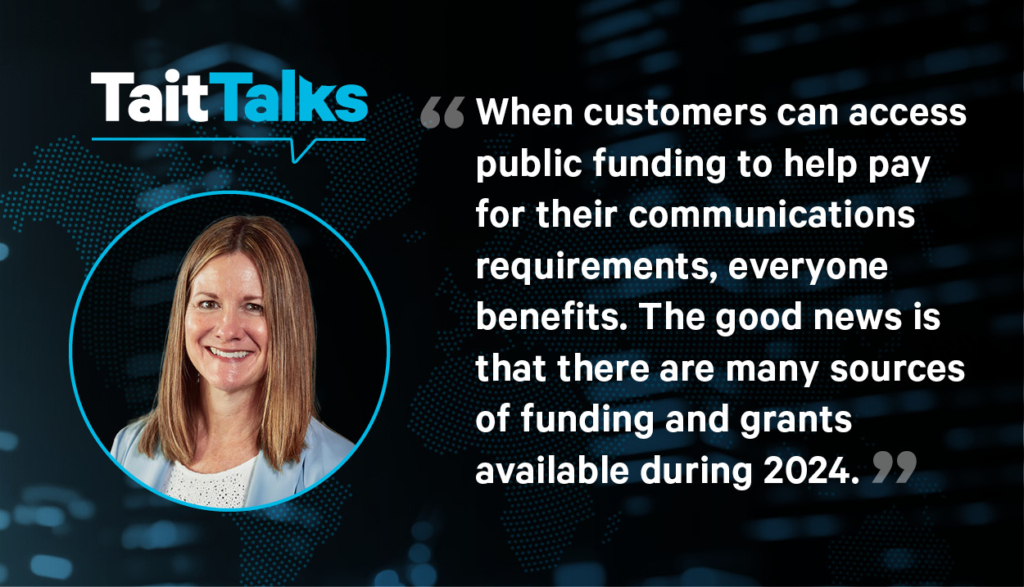With each new year comes new opportunities, and 2024 is no different. Most opportunities need funding to move toward a positive outcome. Join Sandra Wendelken – Tait Market Insights Manager as we explore the various funding opportunities for public safety agencies in 2024.

Mission-critical voice and broadband communications equipment and services are important tools that drive positive outcomes. But communications can also be expensive, so ensuring budgets are in line with planned purchases is always a key to success. When customers can access public funding to help pay for their communications requirements, everyone benefits. The good news is that there are many sources of funding and grants available during 2024. Industry insiders remember the days when the U.S. Department of Homeland Security (DHS) offered millions of dollars in grants specifically to improve LMR interoperability and then later for VHF and UHF narrow banding activities. While there may not ever be grants as specifically targeted at LMR systems and devices again, mission-critical communications customers can take advantage of the available funding vehicles to buy LMR radios and services, as well as mission-critical broadband equipment and services.
Some grant programs are competitive, while some funding is allocated to states, provinces, regions, or jurisdictions based on various criteria such as population. Always check whether there is a matching requirement, which can vary from 20% to 50% depending on the program. For programs where money is allocated to states or provinces, it is important to know the decision makers within that geographic area to ensure your jurisdiction’s requirements are understood and met with any available funding.

In the United States, the first grant program that is anticipated to begin taking applications in January this year is the Assistance to Firefighters Grant (AFG). AFG provided $324 million in grants during 2023. The program helps firefighters and other first responders obtain critically needed equipment, protective gear, emergency vehicles, training, and other resources necessary for protecting the public and emergency personnel from fire and related hazards. The program is competitive with 7,338 applications requesting $2.4 billion during FY22 and 1,707 applications awarded with $324 million allocated. The Federal Emergency Management Agency (FEMA) offers numerous webinars, workshops and resources to help fire departments write a winning application.
Several other FEMA grants, under DHS, are anticipated to open for applications in March 2024 except for Building Resilient Infrastructure and Communications (BRIC), which is taking applications now through Feb. 29, 2024, and the rolling Hazard Mitigation Grant Program. FEMA grants include the following:
- Building Resilient Infrastructure and Communities
- Hazard Mitigation Grant Program
- Emergency Management Performance Grant
- Emergency Operations Center Grant Program
- Homeland Security Grant Program (HSGP)
- State Homeland Security Program (SHSP)
- Urban Area Security Initiative (UASI)
- Operation StoneGarden (OPSG)
- Intercity Bus Security Grant Program (IBSGP)
- Nonprofit Security Grant Program (NSGP)
- Port Security Grant Program (PSGP)
- Transit Security Grant Program (TSGP)
- Tribal Homeland Security Grant Program (THSGP)

Image courtesy of the Federal Transport Administration: https://www.transit.dot.gov/funding/grants/urbanized-area-formula-grants-5307
The Department of Transportation also has grant programs with funding that can be used for communications equipment. These include the Urbanized Area Formula Grants, which offered $7 billion in 2023 for investments in new and existing fixed guideway systems including communications equipment, and the State of Good Repair Grants, with $4.2 billion for equipment for fixed guideway and motorbus systems in urban areas. Both programs are planned to be apportioned in January 2024. The Safe Streets and Roads for All (SS4A) is a five-year grant program in its third year that supports the development of a comprehensive safety action plan that identifies the most significant roadway safety concerns. Applications are anticipated to open in February 2024.
Separately, the Bipartisan Infrastructure Law’s Grid Resilience and Innovation Partnerships (GRIP) program fosters comprehensive solutions that intricately link grid communications systems and operations. The Department of Agriculture’s Telecommunications Infrastructure Loan Program provides loans to organizations looking to improve telecommunications, 9-1-1, and emergency communications services in rural areas, among other purposes.
In addition to grants, U.S. public safety agencies and critical communications industries should also investigate the funding established through the American Rescue Plan Act (ARPA) of 2021 and its Coronavirus State and Local Fiscal Recovery Funds (SLFRF). State, local, and tribal governments have flexibility to use SLFRF funds to provide emergency relief from natural disasters, build critical infrastructure, and support community development. Recipients may use SLFRF funds to provide emergency communications or public transportation, along with emergency protective measures, such as those described in Category B of FEMA’s Public Assistance program to respond before, during, or after a natural disaster. This funding is allocated to state and local governmental entities, so it is important to coordinate with your regional and state local leaders to gain access to this funding. Funding has been allocated to states, counties, cities, local governments, and tribal governments.

Australian Rural firefighters responding to a grass fire.
The Australian government also offers grants for firefighting and rural connectivity, among other areas. Also keep an eye on the government’s Public Safety Mobile Broadband initiative, which could offer funding down the road. For Tait customers outside the U.S. and Australia, check federal and regional government websites for potential public funding opportunities.
Each grant and funding source is different. A pragmatic plan of action is to outline your project needs and then identify one or two programs or funding sources that you feel best meet your requirements and organization criteria. If applicable, get to know the State Administrative Agency (SAA) contacts within your state. Adhere to mandatory government website registrations, deadlines and updates while understanding that preparing for SAA-administered and most other grants begins ahead of the application open date.
In the United States, partnering with nearby jurisdictions tends to help secure funds. In your application, define in layman’s terms your requirements for equipment or systems, and make sure your application is vendor agnostic. Clearly explain the problem or technology gap you are trying to solve, along with the benefits if you receive the funding and the consequences if you do not.
Tait Communications and our global network of channel partners can help direct you to the best funding resources. Your local dealer can also help package and explain the right solution to address your requirements. Please reach out if we can assist in achieving positive financial outcomes this year.
Blog authored by: Sandra Wendelken – Market Insights Manager | Tait Communications
Read the previous Tait Talks topic: A Thank You to Those Who Go Beyond During the Holidays and Year-Round





